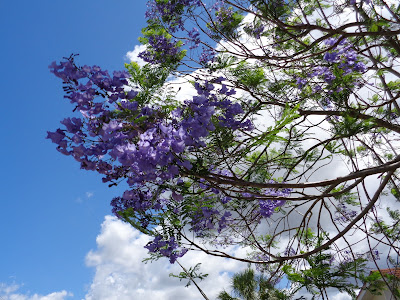Was it a vision of heaven you saw or a jacaranda tree in
full bloom? The spectacle of a large jacaranda tree flush with
lavender-blue blooms and newly emerged feathery leaves can make your eyes focus
like a laser beam on this South American native. A nice tree hiding in
plain sight the rest of the year, you cannot help but love this large flowering
woody ornamental. Blooming intensely for more than thirty-days a year, the
Jacaranda is a top ornamental flowering tree. Even the fallen
flowers are attractive!
Jacarandas are blooming right now in Charlotte County and
surrounding areas. The massive clusters of flowers are arranged in
pyramid-shaped panicles up to a foot long and made up of hundreds of
blossoms. These flowers will be followed by large, woody seed capsules up
to three inches long. Complementing the flowers are twenty-inch
long delicate, feathery leaves. Jacaranda is what is called “briefly
deciduous” referring to the short period of time (generally late winter to
early spring) when the leaves have dropped, but before it flowers and develops
new leaves.
Try to secure trees for planting that have been grafted or
rooted from cuttings. These will tend to bloom quicker than those from
seed which may take years to produce flowers – perhaps up to twenty
years! Growing up to forty-five feet tall with a similar width, this
dome-shaped tree is best for landscapes that can provide the room needed.
Plant young trees in full-sun areas with well-drained soils well away from
hardscapes as large surface roots could be a problem in the future. Keep
clear of poorly drained planting sites as they may encourage root rots to
develop. While fairly drought-tolerant once established, the Jacaranda is
not salt tolerant, so stay away from unprotected coastal
areas. The dappled shade provided by the Jacaranda is
ideal for patios, but can be messy (the leaves and flowers) near pools.
Steer clear of multi-trunked specimens as they are brittle and weak-wooded and
can split at extreme crotch angles when exposed to strong winds. However,
a structurally well-trained and properly pruned Jacaranda can have stronger
wood and be better prepared for windstorms.
The Jacaranda is another Florida-Friendly Landscaping™
recommended tree worth investigating! For more information on other
flowering tree suitable for our area, please call our Master Gardener
volunteers on the Plant Lifeline on Mondays, Wednesdays and Fridays from 1 to 4
pm at 764-4340 for gardening help and insight into their role as an Extension
volunteer. Don't forget to visit our other County Plant Clinics in the
area. Please check this link for a complete list of site locations, dates
and times - http://charlotte.ifas.ufl.edu/horticulture/Plant%20Clinics%20Schedule.pdf.
Resources:
Gilman, E. F. & Watson, D. G. (2014) Jacaranda
mimosifolia: Jacaranda. The University of Florida Extension Service,
IFAS.
Brown, S. H. (2012) Jacaranda mimosifolia. The
University of Florida Extension Service, IFAS – Lee County.
Scheper, J. (2006) Jacaranda acutifolia. Floridata.com,
Tallahassee, FL.

No comments:
Post a Comment